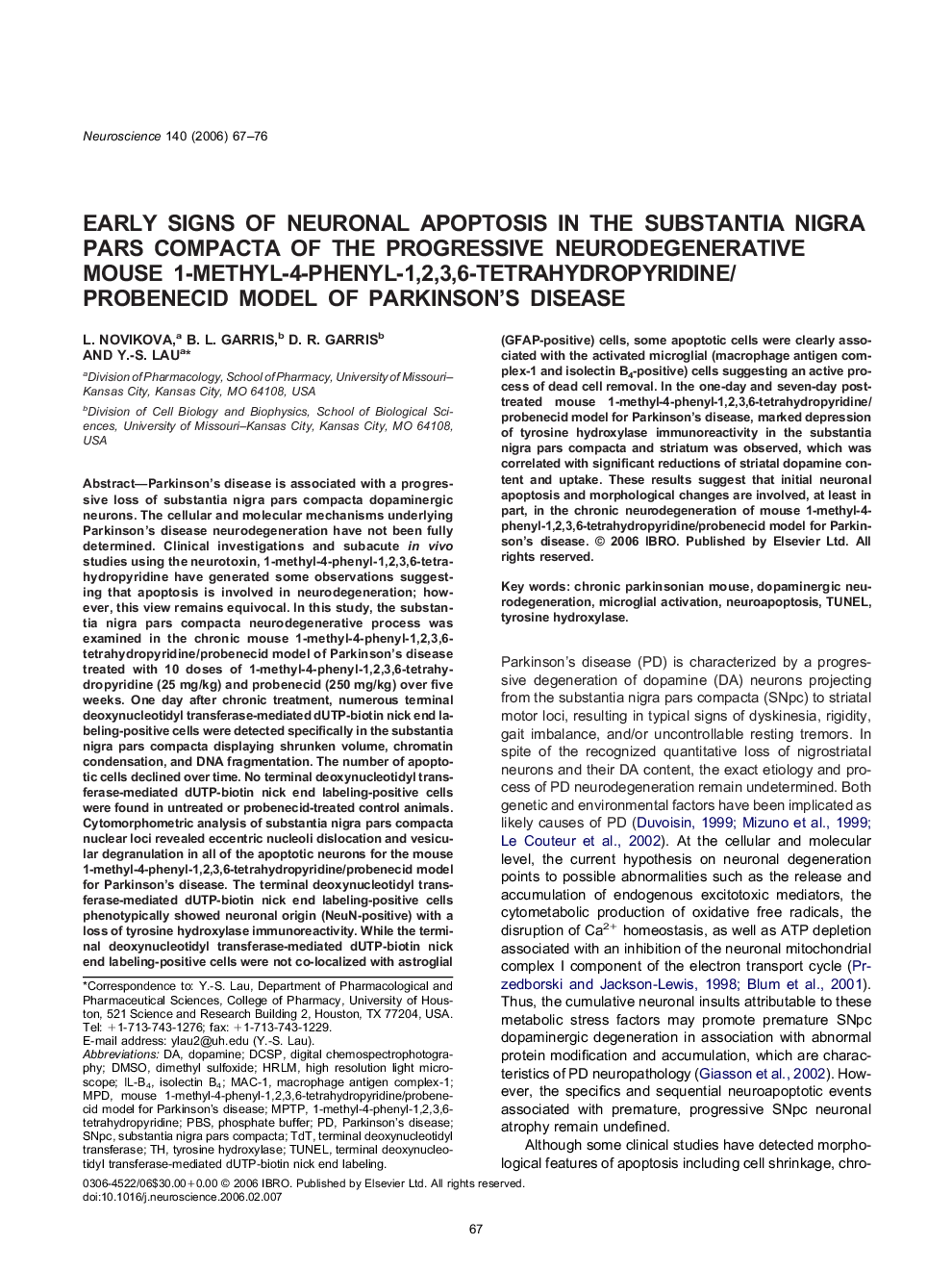| کد مقاله | کد نشریه | سال انتشار | مقاله انگلیسی | نسخه تمام متن |
|---|---|---|---|---|
| 4342806 | 1295902 | 2006 | 10 صفحه PDF | دانلود رایگان |
عنوان انگلیسی مقاله ISI
Early signs of neuronal apoptosis in the substantia nigra pars compacta of the progressive neurodegenerative mouse 1-methyl-4-phenyl-1,2,3,6-tetrahydropyridine/probenecid model of Parkinson's disease
دانلود مقاله + سفارش ترجمه
دانلود مقاله ISI انگلیسی
رایگان برای ایرانیان
کلمات کلیدی
PBSterminal deoxynucleotidyl transferase-mediated dUTP-biotin nick end labelingTdTmPDMPTP1-methyl-4-phenyl-1,2,3,6-tetrahydropyridine - 1-methyl-4-phenyl-1،2،3،6-tetrahydropyridineDMSO - DMSOSNpc - SNPCisolectin B4 - ایزوکتین B4phosphate buffer - بافر فسفاتParkinson’s disease - بیماری پارکینسونterminal deoxynucleotidyl transferase - ترمینال deoxynucleotidyl transferasesubstantia nigra pars compacta - توده سیاه پارس متراکمTUNEL - تونلtyrosine hydroxylase - تیروزین هیدروکسیلازDopamine - دوپامینDimethyl sulfoxide - دیمتیل سولفواکسیدDopaminergic neurodegeneration - عصب دیوپامینرژیکmicroglial activation - فعال سازی microglialMac-1 - مک 1Neuroapoptosis - نوروپاپتوزیس
موضوعات مرتبط
علوم زیستی و بیوفناوری
علم عصب شناسی
علوم اعصاب (عمومی)
پیش نمایش صفحه اول مقاله

چکیده انگلیسی
Parkinson's disease is associated with a progressive loss of substantia nigra pars compacta dopaminergic neurons. The cellular and molecular mechanisms underlying Parkinson's disease neurodegeneration have not been fully determined. Clinical investigations and subacute in vivo studies using the neurotoxin, 1-methyl-4-phenyl-1,2,3,6-tetrahydropyridine have generated some observations suggesting that apoptosis is involved in neurodegeneration; however, this view remains equivocal. In this study, the substantia nigra pars compacta neurodegenerative process was examined in the chronic mouse 1-methyl-4-phenyl-1,2,3,6-tetrahydropyridine/probenecid model of Parkinson's disease treated with 10 doses of 1-methyl-4-phenyl-1,2,3,6-tetrahydropyridine (25 mg/kg) and probenecid (250 mg/kg) over five weeks. One day after chronic treatment, numerous terminal deoxynucleotidyl transferase-mediated dUTP-biotin nick end labeling-positive cells were detected specifically in the substantia nigra pars compacta displaying shrunken volume, chromatin condensation, and DNA fragmentation. The number of apoptotic cells declined over time. No terminal deoxynucleotidyl transferase-mediated dUTP-biotin nick end labeling-positive cells were found in untreated or probenecid-treated control animals. Cytomorphometric analysis of substantia nigra pars compacta nuclear loci revealed eccentric nucleoli dislocation and vesicular degranulation in all of the apoptotic neurons for the mouse 1-methyl-4-phenyl-1,2,3,6-tetrahydropyridine/probenecid model for Parkinson's disease. The terminal deoxynucleotidyl transferase-mediated dUTP-biotin nick end labeling-positive cells phenotypically showed neuronal origin (NeuN-positive) with a loss of tyrosine hydroxylase immunoreactivity. While the terminal deoxynucleotidyl transferase-mediated dUTP-biotin nick end labeling-positive cells were not co-localized with astroglial (GFAP-positive) cells, some apoptotic cells were clearly associated with the activated microglial (macrophage antigen complex-1 and isolectin B4-positive) cells suggesting an active process of dead cell removal. In the one-day and seven-day post-treated mouse 1-methyl-4-phenyl-1,2,3,6-tetrahydropyridine/probenecid model for Parkinson's disease, marked depression of tyrosine hydroxylase immunoreactivity in the substantia nigra pars compacta and striatum was observed, which was correlated with significant reductions of striatal dopamine content and uptake. These results suggest that initial neuronal apoptosis and morphological changes are involved, at least in part, in the chronic neurodegeneration of mouse 1-methyl-4-phenyl-1,2,3,6-tetrahydropyridine/probenecid model for Parkinson's disease.
ناشر
Database: Elsevier - ScienceDirect (ساینس دایرکت)
Journal: Neuroscience - Volume 140, Issue 1, 2006, Pages 67-76
Journal: Neuroscience - Volume 140, Issue 1, 2006, Pages 67-76
نویسندگان
L. Novikova, B.L. Garris, D.R. Garris, Y.-S. Lau,